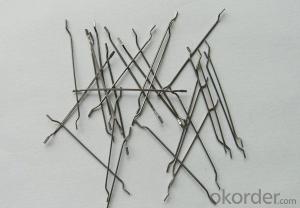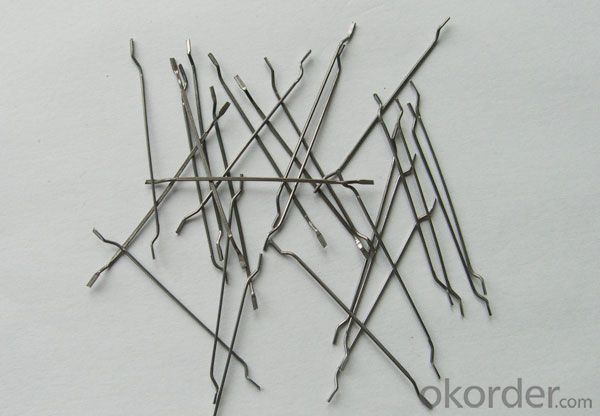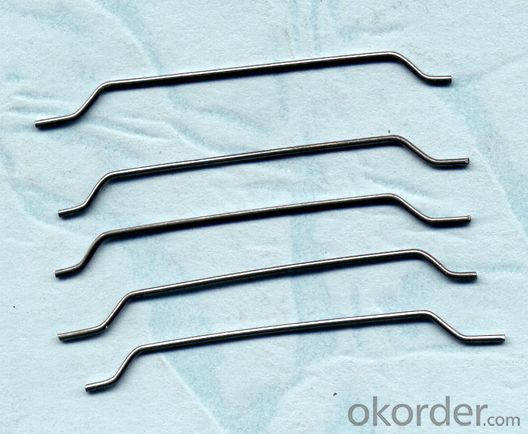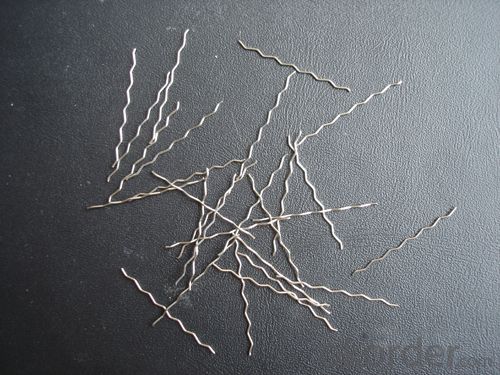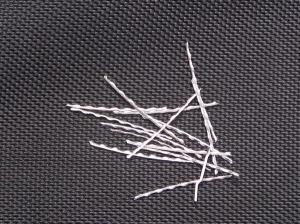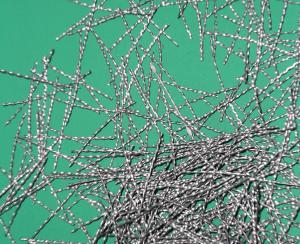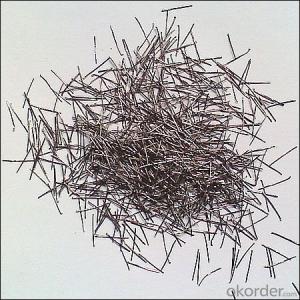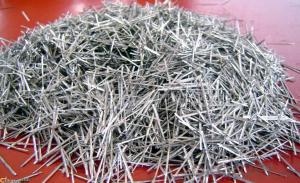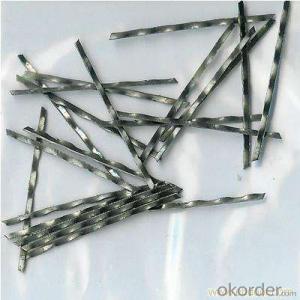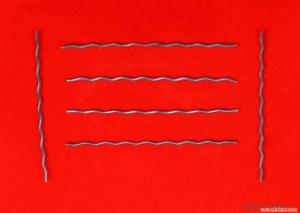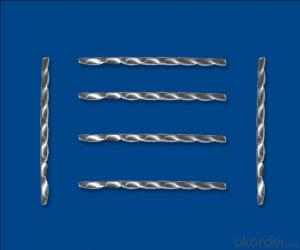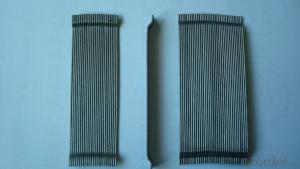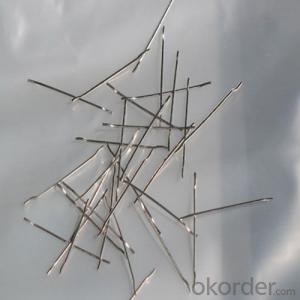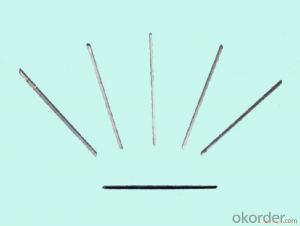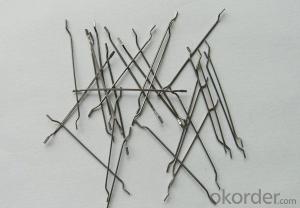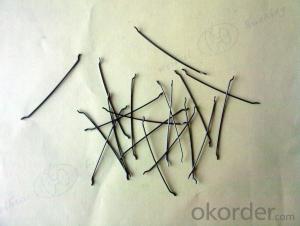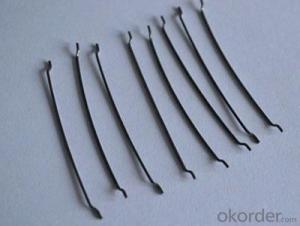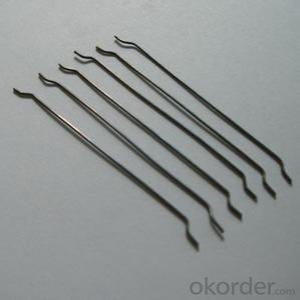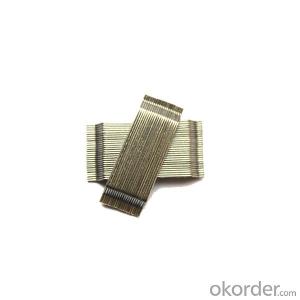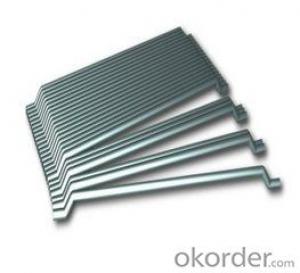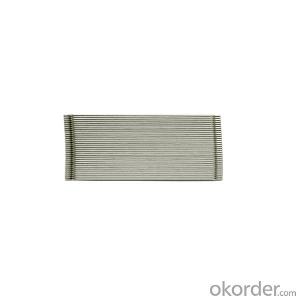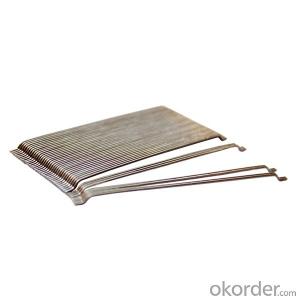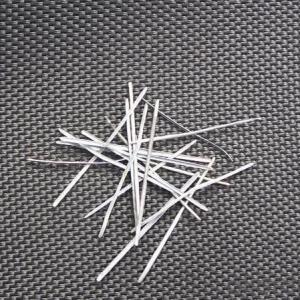Melt Extract Stainless Steel Fiber - Straight Type Steel Fiber from CNBM China
- Loading Port:
- Tianjin
- Payment Terms:
- TT OR LC
- Min Order Qty:
- 1000 kg
- Supply Capability:
- 30000 kg/month
OKorder Service Pledge
OKorder Financial Service
You Might Also Like
Quick Details
Place of Origin: Jiangsu, China (Mainland)
Model Number: HT-ST
Material: Steel
Specifications
Product overview
1, through the ISO9001 certification
More than
2, Material: low carbon steel wire
3. Shape: Hooked ends
4. High strength and high discount and the anchoring force is strong
5, The best effect in general, widely used in industrial floor and on the road
hook steel fiber
1, the length of 25 - 60 mm
2, the diameter of 0.5-1.0 mm
| Packaging Details: | Paper bag + pallet 25 kg / bag, 40 bags / pallet, 1 ton / pallet |
| Delivery Detail: | 15 |
Picture
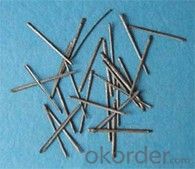
Steel fiber straight type
FAQ
certificated: ISO 9001
Technical advantages of Daye steel fiber:
Improve mechanical performance of concrete
Provide uniform distribution throughout concrete with excellent mixing
No balling or caking by adopt correct mixing method
Reduce concrete volume
Save construction time and cost
Reduce excavation volume
Available for jointless floor.
certificated: ISO 9001
Technical advantages of Daye steel fiber:
Improve mechanical performance of concrete
Provide uniform distribution throughout concrete with excellent mixing
No balling or caking by adopt correct mixing method
Reduce concrete volume
Save construction time and cost
Reduce excavation volume
Available for jointless floor.
- Q: How does the addition of melt extract stainless steel fiber affect the setting time of concrete?
- The addition of melt extract stainless steel fiber can affect the setting time of concrete in a few ways. Firstly, the stainless steel fibers can act as nucleation sites for the formation of hydration products, which can accelerate the setting time of concrete. This is because the stainless steel fibers provide additional surface area for the hydration reactions to occur, leading to faster cement hydration and setting. Secondly, the stainless steel fibers can also improve the overall mechanical properties of the concrete, such as its tensile strength and crack resistance. This can indirectly affect the setting time of concrete by reducing the need for extended curing periods. With improved mechanical properties, the concrete can reach its desired strength faster, allowing for shorter setting times. However, it is important to note that the addition of melt extract stainless steel fiber should be carefully controlled to avoid any negative effects on the setting time of concrete. Excessive amounts of fibers can hinder the flowability of the concrete mixture, leading to longer setting times. Therefore, it is crucial to find the right dosage of stainless steel fibers to achieve the desired setting time and mechanical properties of the concrete. Additionally, the specific characteristics of the stainless steel fibers, such as their length and aspect ratio, can also influence the setting time of concrete and should be taken into consideration during the design and mixing process.
- Q: How does melt extract stainless steel fiber affect the shrinkage and creep of concrete?
- Melt extract stainless steel fiber is commonly used as a reinforcement material in concrete to improve its overall strength and durability. When added to concrete, these fibers provide additional tensile strength and reduce the potential for cracking. In terms of shrinkage, melt extract stainless steel fibers can help minimize the shrinkage of concrete. Shrinkage occurs as water evaporates from the concrete during the curing process, leading to volume reduction. The addition of stainless steel fibers helps to distribute the internal stresses and restrain the shrinkage. This results in reduced shrinkage cracks and an overall decrease in the amount of shrinkage experienced by the concrete. Similarly, when it comes to creep, which is the time-dependent deformation of concrete under sustained load, melt extract stainless steel fibers play a crucial role. Creep occurs due to the ongoing chemical and physical processes within the concrete, causing it to gradually deform over time. The presence of stainless steel fibers in the concrete helps to control this creep deformation by providing additional resistance against the applied load. The fibers act as a reinforcement, distributing the stresses and reducing the overall creep strain in the concrete. In summary, the addition of melt extract stainless steel fiber to concrete significantly affects the shrinkage and creep properties. It helps to minimize shrinkage by distributing internal stresses and restraining volume reduction. Additionally, it controls creep deformation by providing additional resistance against sustained loads and reducing the overall creep strain. Overall, the presence of stainless steel fibers improves the long-term performance and durability of concrete structures.
- Q: How does melt extract stainless steel fiber improve the impact resistance of airport pavements?
- The impact resistance of airport pavements can be greatly enhanced with the use of melt extract stainless steel fiber. This material is commonly employed as reinforcement in concrete to enhance its mechanical properties and increase its durability. By incorporating melt extract stainless steel fiber into airport pavements, their capacity to withstand impact forces is significantly improved. When aircraft land or take off, they exert immense pressure and impact on the pavement surface. Without adequate reinforcement, this can result in cracking, spalling, and other forms of damage. The stainless steel fiber functions as reinforcement by dispersing the stress caused by impact forces over a wider area. This helps to distribute the load and prevent concentrated pressure points, which are more susceptible to damage. Consequently, the airport pavements become more resistant to cracking and other forms of structural failure. Additionally, melt extract stainless steel fiber also enhances the overall toughness of the pavement. It effectively impedes the propagation of cracks, limiting their length and depth. This significantly reduces the risk of extensive damage and prolongs the lifespan of the pavement. Moreover, the stainless steel fiber provides increased resistance to fatigue. Airport pavements undergo repetitive loading and unloading cycles that can lead to fatigue failure over time. The inclusion of stainless steel fiber enhances the pavement's ability to withstand these cyclic loads, diminishing the likelihood of fatigue cracks and enhancing its overall resilience. In conclusion, melt extract stainless steel fiber is a valuable material for augmenting the impact resistance of airport pavements. Its incorporation into concrete reinforcement greatly enhances the pavement's ability to endure the pressure and impact forces generated by aircraft during landing and takeoff. This reinforcement disperses stress, impedes crack propagation, improves toughness, and enhances resistance to fatigue, ultimately resulting in a longer-lasting and more durable pavement.
- Q: What are the requirements for storage and handling of melt extract stainless steel fiber?
- The requirements for storage and handling of melt extract stainless steel fiber include several key factors to ensure the integrity and quality of the product. 1. Temperature: The storage area should be maintained at a moderate temperature to prevent any adverse effects on the stainless steel fiber. Extreme high or low temperatures can potentially alter the properties of the fiber and affect its performance. 2. Humidity: It is important to store the melt extract stainless steel fiber in a dry environment to avoid any moisture absorption. Moisture can lead to corrosion and weaken the fiber, thereby reducing its effectiveness. 3. Packaging: The fiber should be stored in its original packaging or airtight containers to prevent exposure to air, dust, and other contaminants. This helps to maintain the cleanliness and quality of the fiber. 4. Handling: When handling the stainless steel fiber, it is crucial to use appropriate protective equipment such as gloves and safety glasses to avoid any injuries. The fiber can have sharp edges, so care should be taken to prevent cuts or abrasions. 5. Avoiding contact with other metals: The stainless steel fiber should be stored separately from other metals, especially those that are prone to corrosion. Contact with other metals can cause galvanic corrosion, which can degrade the fiber's performance. 6. Proper labeling and identification: It is important to properly label and identify the melt extract stainless steel fiber to ensure its traceability and avoid any confusion with other materials. This helps in maintaining quality control and efficient inventory management. By following these requirements for storage and handling, the melt extract stainless steel fiber can be preserved in its optimal condition, ensuring its reliability and longevity in various applications such as reinforcement in concrete, thermal insulation, and electrical conductivity.
- Q: How does melt extract stainless steel fiber improve the ductility of concrete?
- Melt extract stainless steel fiber improves the ductility of concrete by acting as a reinforcement material that enhances its ability to withstand tensile stresses. The addition of these fibers increases the flexural strength and crack resistance of concrete, allowing it to better absorb energy and deform under loading without fracturing. This improved ductility ultimately leads to a more durable and resilient concrete structure.
- Q: Does melt extract stainless steel fiber improve the resistance to chloride ingress in shotcrete?
- The utilization of melt extract stainless steel fibers indeed enhances the capability of shotcrete to withstand chloride ingress. Concrete structures are susceptible to corrosion caused by chloride ions, particularly in marine environments or areas with high chloride salt exposure. By incorporating melt extract stainless steel fibers into the shotcrete mix, the durability and resistance of the concrete against chloride penetration are significantly improved. Melt extract stainless steel fibers are specially designed for reinforcing concrete and shotcrete applications. These fibers are manufactured using top-notch stainless steel material, which possesses exceptional corrosion resistance properties. When introduced into the shotcrete mix, the stainless steel fibers establish a three-dimensional network within the concrete matrix, effectively distributing stress and preventing crack formation. Regarding resistance against chloride ingress, the presence of melt extract stainless steel fibers acts as a physical barrier that hinders the movement of chloride ions into the concrete. The fibers create a complex pathway for the chloride ions to traverse, consequently decelerating their penetration rate. This, in turn, greatly diminishes the likelihood of corrosion initiation and propagation within the concrete. Moreover, melt extract stainless steel fibers enhance the overall durability of shotcrete by increasing its resistance to freeze-thaw cycles, abrasion, impact, and other forms of deterioration. This extended lifespan further contributes to the augmented resistance against chloride ingress, as the concrete remains structurally intact and less susceptible to corrosion induced by chloride. It is crucial to acknowledge that although melt extract stainless steel fibers offer significant advantages in terms of chloride ingress resistance, they should be used in combination with other corrosion prevention measures, such as appropriate concrete cover, waterproofing systems, and suitable concrete mix design. Additionally, the dosage and distribution of stainless steel fibers within the shotcrete mixture should be meticulously determined based on the specific demands and exposure conditions of the project.
- Q: Can melt extract stainless steel fiber be used in the construction of water storage tanks?
- Yes, melt extract stainless steel fiber can be used in the construction of water storage tanks. Stainless steel fibers are known for their high corrosion resistance and durability, making them suitable for use in water storage tanks where they can withstand the corrosive nature of water and provide structural reinforcement.
- Q: How does melt extract stainless steel fiber improve the durability of sprayed concrete?
- Melt extract stainless steel fiber improves the durability of sprayed concrete by enhancing its strength and resistance to cracking. The fibers act as reinforcement, providing additional tensile strength to the concrete. This helps to prevent the formation and propagation of cracks, increasing the overall durability and lifespan of the sprayed concrete.
- Q: How does the addition of melt extract stainless steel fiber affect the workability of concrete?
- By incorporating melt extract stainless steel fiber, the workability of concrete can be significantly affected. These fibers, which are thin strands, are mixed into the concrete during the mixing process. Typically, they are added in small percentages ranging from 0.5% to 2% by volume. When stainless steel fibers are added to concrete, one of the primary outcomes is an enhancement in workability. Workability, in this context, refers to how easily concrete can be mixed, placed, and finished. By improving the cohesiveness and flowability of the concrete mixture, stainless steel fibers make it more manageable and manipulable during construction. These fibers serve as reinforcement agents within the concrete, increasing its resistance to cracking, shrinkage, and deformation. Consequently, the overall strength and durability of the concrete are improved, making it more resilient against external forces and environmental conditions. Furthermore, the addition of stainless steel fibers can also improve the plasticity of the concrete, leading to better compaction and consolidation. As a result, the hardened concrete attains increased density and reduced porosity, thereby enhancing mechanical properties like compressive strength and flexural strength. Nevertheless, it is important to acknowledge that adding stainless steel fibers can also present some challenges to the workability of concrete. The fibers may cause the mixture to become slightly sticky, making it more difficult to handle and place. Additionally, the presence of fibers can increase the viscosity of the concrete, making it harder to pump and transport. In conclusion, by adding melt extract stainless steel fiber to concrete, its workability can be positively influenced through improved cohesiveness, flowability, and plasticity. Nonetheless, careful consideration of dosage and mix design is necessary to ensure that the desired workability is achieved without compromising other concrete properties.
- Q: Does melt extract stainless steel fiber improve the flexural strength of concrete?
- The flexural strength of concrete can be improved by using melt extract stainless steel fiber. This specific type of fiber is produced by melting stainless steel and then extracting it into thin fibers. These fibers are added to concrete mixtures to boost its mechanical properties, particularly its flexural strength. By incorporating melt extract stainless steel fibers into concrete, they serve as reinforcement by evenly distributing stresses throughout the material. This helps prevent cracking and increases the overall strength of the concrete when subjected to bending or flexural conditions. Furthermore, the high tensile strength and ductility of stainless steel fibers contribute to the enhanced flexural strength of concrete. These fibers effectively resist the tensile forces that occur during flexural loading, resulting in a more durable and resilient concrete structure. In summary, the addition of melt extract stainless steel fibers significantly enhances the flexural strength of concrete, making it a popular choice for various applications such as pavements, industrial floors, and structural elements that experience bending or flexural forces.
Send your message to us
Melt Extract Stainless Steel Fiber - Straight Type Steel Fiber from CNBM China
- Loading Port:
- Tianjin
- Payment Terms:
- TT OR LC
- Min Order Qty:
- 1000 kg
- Supply Capability:
- 30000 kg/month
OKorder Service Pledge
OKorder Financial Service
Similar products
Hot products
Hot Searches
Related keywords
